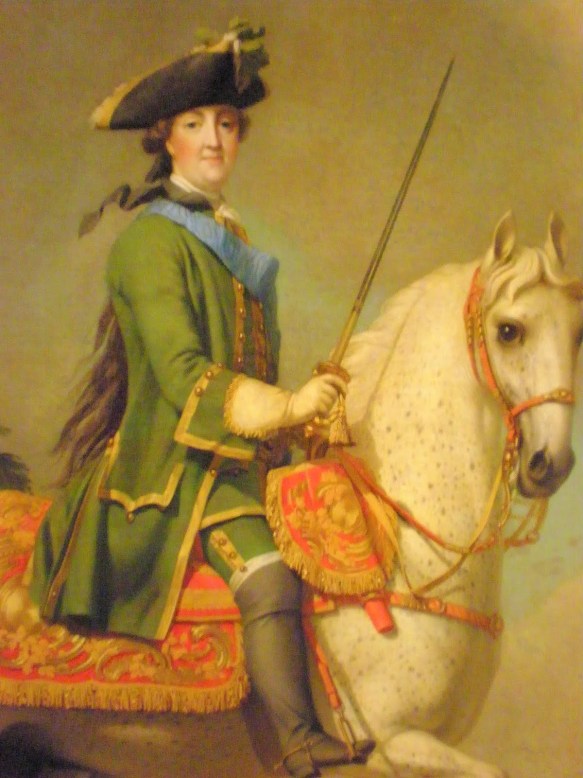
Equestrian portrait of Catherine in the Preobrazhensky Regiment’s uniform.
Battle of Chesme.
The Ottoman Empire ceded some land to Russia directly (red-green stripe) and indirectly via the independence of Crimean Khanate (yellow-green stripe) which the Russians would annex in 1783.
Czarina Catherine II “the Great” (1729-96) of Russia intervened militarily in Poland’s succession problems and failed to comply with the terms of the treaty ending the RUSSO-TURKISH WAR OF 1736-39. The ill-prepared Ottoman Empire declared war in 1768 when Russian forces, pursuing Poles into Turkish lands, sacked a Turkish town. Turkish forces, with Austrian support, lost battles against the invading Russians in Georgia, Kabardia, Crimea, and the Baltic; when the main Ottoman army was routed along the Dniester River, the Russians overran Moldavia and Wallachia in 1769. The Turks, aided by Albanians, were able to quell a Russian-incited and -supported revolt in Greece in 1770. Nonetheless, the entire Ottoman fleet was destroyed by the Russians at the Battle of Çeçme in the Aegean Sea on July 6, 1770, and a Turkish-Tatar army, attempting to recapture Moldavia, was devastated and forced to retreat in August 1770. Turkish fortresses along the Danube, Dniester, and Pruth rivers were captured. An invading Russian army conquered the Crimea (1771), while in Egypt and Syria revolts broke out against Turkish rule but were eventually put down in 1773.
At the Conference of Bucharest (1773) Russia proposed peace terms, which the Ottomans rejected, and the war continued with Russian forces under the victorious Count Petr Rumiantsev (1725-96) moving south along the Danube to engage the main Ottoman army. Other Russians assaulted Varna and Silistria, and the Turkish grand vizier entered into peace negotiations with Rumiantsev. In June 1744, the Turks lost much of their main army when Russians under Count Aleksandr Suvorov (1729-1800) won a battle near Shumla. On July 16, 1774, the Treaty of Kuchuk-Kainardji was signed by the Turks and Russians, who were now involved in PUGACHEV’S REVOLT. Moldavia and Wallachia were returned to Turkish suzerainty; Crimea became independent; and Russia received control of much of the northern Black Sea coast and the ambiguous right to intervene in Turkish affairs to protect Orthodox interests (this provision created the ongoing “Eastern Question,” what happened to European lands under Turkish control).
Catherine the Great’s Second War with the Turks (1787-92) (Russo-Turkish War of 1787- 92). Russia’s annexation of the Crimea (1783) and desire to make Georgia a protectorate, plus the Turks’ attempts to foment a Tatar revolt, led to a renewal of Catherine’s war (it was rumored that she desired to absorb the Ottoman Empire). In 1788, Suvorov repelled a Turkish effort to seize the Crimea, and Rumiantsev invaded Moldavia. The Russian Black Sea fleet commanded by the American naval hero John Paul Jones (1747-92), in the Russian service as a rear admiral, won two naval battles near the mouth of the Dnieper River in June 1788. In Moldavia and along the Black Sea, the Russians massacred the captured Turkish inhabitants of Chocim (Khotin), Jassy (Iasi), and Ochakov (1788) and, supported by Austrians, defeated the Ottomans at the Battle of Focsani on the Moldavian-Wallachian border (1789). Austrians repulsed invading Turks in Serbia and took Belgrade. With the accession of Austria’s anti-Russian emperor Leopold II (1747-92) came an Austrian-Turkish peace treaty at Sistova in 1791, and Belgrade was returned to the Ottomans. As Russia continued its successful push into Ottoman territory, the sultan made peace by the Treaty of Jassy on January 9, 1792. Russia returned Moldavia but retained Ochakov and all conquered lands east of the Dniester River, which became the Ottoman-Russian border.